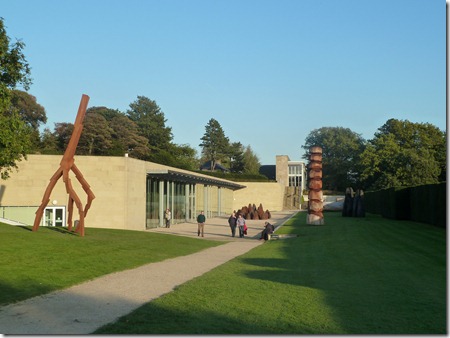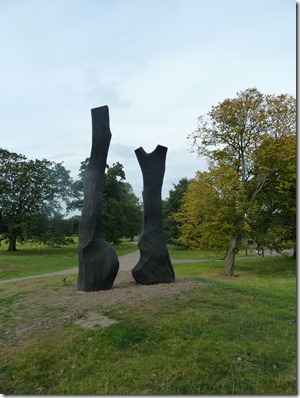Last year we made two visits to the Yorkshire Sculpture Park near Wakefield where, as well as looking at the large collection of works by Henry Moore and other permanent or semi-permanent exhibits in the grounds, we saw major exhibitions by Isamu Noguchi and Peter Randall-Page. This year, the YSP are staging a major exhibition of work by David Nash. We went over to have a look at it in August and enjoyed it, but there was so much to see that we decided we needed to go back to have another look, so made the journey back over the Pennines a couple of weeks ago when I had a week off work.
“Black ball”
There were works displayed in all four galleries and outside in the grounds. Several pieces have been created especially for the exhibition, including a permanent installation – the Oxley Bank “Black Steps”.
David Nash principally creates his works from wood, often taking his inspiration from the natural forms of the trees he selects or finds. One aspect of his work I found particularly interesting was his use of “tree quarries” – fallen trees he uses to create several different works.
“Red column”
Some of his works are very large in scale and must have been difficult to transport, move around and install in the galleries. This is particularly the case with “Oculus block” a massive piece of created from eucalyptus wood from California. The picture below (taken from the gallery’s Flickr site) really doesn’t give a proper impression of its scale.
Oculus Block from the YSPs Flickr site
From the gallery’s information on this piece:
“Oculus is Latin for eye but is used in this case to refer to a hole that runs down the centre of the piece. The wood cut from the sculpture is arranged against the walls, setting up a kind of rhythm between the centre and edges of the space.”
There’s a simplicity to his works – both in their form and the way he lets the colour of the wood stand for itself, although he does apply colour by staining some of his pieces. He also uses charring effectively. In most cases this is controlled so only the surface is charred, and the natural colour of the wood can be seen in places through cracks and splits.
“Trunk and Butt” – two charred pieces created on site at the Longside gallery.
Unlike many other sculpture exhibitions visitors are allowed to touch most of the works displayed in the indoor galleries – in fact the staff seem to encourage you to do so. (However you are not allowed to touch those works which are charred – too many people touching them would eventually cause damage). Nash is interested in change and is not afraid to let this happen with his work. Wood is affected by the elements and will split, warp and deform even without human intervention as it dries, seasons or absorbs moisture under damp conditions. The changes will be different depending on whether the pieces are displayed indoors or outdoors. The effects can be seen in many of the works on display and you can see how he has used these natural changes as part of the creative process.
Nash also creates living “planted works” where he plays with nature. Examples include the “Ash dome”, “Planted Larches” and “Bluebell ring” created in woodland near his studio. Of course, these can’t be transported across the country, but the final room in the Underground Gallery, the “Project Space”, contains exhibits – drawings, photographs and a video – relating to these works.
Some of the living works will have taken years to plan and realise and Nash must be extraordinarily patient. This was certainly the case with his “Wooden boulder” project. He carved a boulder like shape from a section of one of his tree quarries at his home and studio near Blaenau Ffestiniog and dumped it in the nearby river. He followed its progress down the river to the sea near Portmadog, filming, drawing and photographing it over twenty odd years until it disappeared out to sea. There was a short video film about the project shown in the , together with some related drawings and other pieces from the same “tree quarry” in the Bothy Gallery.
Not all the works displayed are made from wood – there are a small number of metal pieces – one of them, “King and Queen” displayed near the entrance to the park, a bronze casting of a pair of wooden sculptures shown in the Underground gallery.
Bronze castings of “King and Queen”
In addition to the sculptures, there were a number of pictures displayed in the exhibition. Again these are quite simple, with only a few strong colours. I also liked his “family trees” , displayed in the Longsight gallery, which illustrated the development and evolution of his work and the connections between the different pieces.
A short documentary film about David Nash’s work and the creation of the exhibition was showing in the main reception building. Unfortunately copies weren’t on sale, but some sections can be viewed online on the YSP’s Vimeo channel.
Online Gallery on the Guardian website
Pictures from the YSP Flickr site







Pingback: Norman Dilworth Sculptures and Drawings at the Turnpike « Down by the Dougie
Pingback: David Nash at Kew Gardens | Down by the Dougie